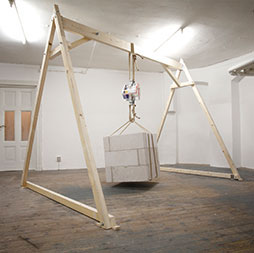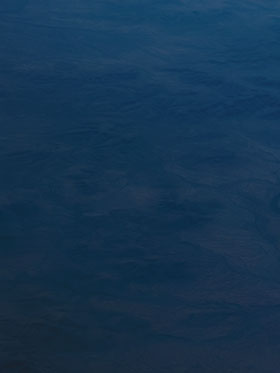 100 years from now...
100 years from now...
Jack Pam
Trevor Vickers, an artist of obvious and significant talent, introduced himself at The Undiscovered symposium with a presentation that for me was truly inspiring. His earliest important experience and moment of connection to art, as he told it, was a chance encounter brought about by boredom during his lunchtime work break in the Melbourne CBD. He went into the city’s museum seeking a glimpse of the taxidermied Phar Lap. After he had seen the Australian sporting icon, which he observed was “just a horse,” his attention was arrested by a collection of paintings by European master artists. Trevor described how this began a rich and diverse informal art education energetically mined from local and international art galleries, museums, artists studios, important friendships and social interactions.
This was something that resonated with me. Although I did try to go to art school, what I have learnt about art has come more from an accidental series of events, chance encounters and a constant hunger for it. Trevor’s talk left me thinking about how lucky we are that he found his way in front of works that caused a chain of events resulting in his own output of artworks that is now continuing the process of inspiring us.
There was a missing voice amongst the varied offerings at The Undiscovered symposium and that was of a younger generation of artists who are, sometimes very quietly, building, creating and exploring.
Within our city and abroad we have Western Australian artists, curators and writers who are engaging globally. Jackson Eaton, currently based in Melbourne, has progressed from a good photographer to an artist who uses photography as a witness of elaborate performative and provocative ideas. His work has been published widely and exhibited at significant art establishments in Australia and elsewhere in the world. Perth born Eloise Sweetman and Perth educated Jason Hendrik Hansma have lived in Rotterdam for the last few years and currently collaborate on writing, research and visual explorations that have contributed to art initiatives across Europe and the Americas, as well as in Australia. Berlin based Christopher Charles was brought up being pulled across the pacific north west in Canada as well as rural Western Australia and Perth. He has delivered three solo exhibitions in the last 15 months in London, Berlin and Moscow. This list continues and provides an unpredictable and diverse collection of artists and creative practitioners who perhaps don’t fit the stereotype of a Western Australian artist. The important connection between these individuals, both locally and internationally based, is that they are doing it for themselves. They are stealing their own opportunities and they are creating new work that is gaining critical success and admiration from their international peers. I have experienced this first hand living in Europe for the past decade, at first exhibiting as an artist and more recently curating, publishing and writing.
 What I miss when I am back in Australia is the everyday nature of art as part of city living and how creative dialogues consistently punctuate normal events. I also miss seeing great pieces of art by masterful, established practitioners, both living and long gone. Most of all I miss seeing these masters in conversation with new creative thinkers. Lisa Slade, curator of the 2016 Adelaide Biennial, spoke at the symposium about recent and upcoming projects that are formulated around this idea. Her lateral approach to storytelling was evident in her curatorial output, exploring ideas across multiple generations of artists and including artworks sourced by unique and novel means. This open framework and inclusive way of thinking breaks down traditional ideas of what art is and how it should be perceived. What I understood from her presentation is that the story within an exhibition becomes the important driving factor in her curatorial process as she pushes young artists through delicate commissions and places their work in a larger demographic and geographic context. Curatorial projects like those Lisa undertakes have the potential to bring a new level of engagement and interest to a larger audience.
What I miss when I am back in Australia is the everyday nature of art as part of city living and how creative dialogues consistently punctuate normal events. I also miss seeing great pieces of art by masterful, established practitioners, both living and long gone. Most of all I miss seeing these masters in conversation with new creative thinkers. Lisa Slade, curator of the 2016 Adelaide Biennial, spoke at the symposium about recent and upcoming projects that are formulated around this idea. Her lateral approach to storytelling was evident in her curatorial output, exploring ideas across multiple generations of artists and including artworks sourced by unique and novel means. This open framework and inclusive way of thinking breaks down traditional ideas of what art is and how it should be perceived. What I understood from her presentation is that the story within an exhibition becomes the important driving factor in her curatorial process as she pushes young artists through delicate commissions and places their work in a larger demographic and geographic context. Curatorial projects like those Lisa undertakes have the potential to bring a new level of engagement and interest to a larger audience.
It is great to see a curator with this approach working at senior levels in the art industry of Australia but it should not be uncommon for this dramatic sense of storytelling and visual exploration to be evident across the board in the visual arts. An inclusive spirit and the continual act of support to young artists, pitched alongside mid and late-career veterans, can drive the energy of art exhibitions.
Audiences have changed in the 21st century and how events and art initiatives engage with audiences needs to adapt. It is no longer good enough to put on great exhibitions of great art and wait for people to come.
The Internet is one of the many ways to extend the life of a project and to seek out the potential for new audiences for future projects. Respectable stand-alone online projects exist that have expanded audiences’ online tolerance and understanding of web based art. Projects such as the New York-based New Museum’s Rhizome, a platform that incubates and showcases new creative methods of maintaining arts discourse online are achieving positive engagements by audiences. The ambitiously large and all-encompassing art wikipedia art.sy is another example, as is the gentle and expertly curated monthly screening program, vdrome. The Internet is definitely not, at least by itself, a way of solving the problems of an undiscovered art scene but it does have some powerful tools to be used and abused by our local practitioners and art sector workers.
It was clear during The Undiscovered and it is clear living here, that there is an art scene in Perth and that it has some brilliant contributors. However, it appears to be in dire need of combined effort towards a shared goal. This theme repeated throughout the day – “we need to work together!” Initiatives such as San Francisco’s First Thursday Art, Berlin’s Art Week and Carte Blanche rates and deals in Paris allow artists to collectively speak to larger audiences and over time have helped develop and shape thriving art industries.
The steps we take to gaining local, national or global discovery are going to be as unique as we are individual. Our state’s cultural identity will grow when smaller artist run initiatives proliferate and populate the artistic landscape. Small commercial art galleries, well run public project spaces as well as no-budget artist run exhibition centres feed an energetic artistic landscape. This increases the volume of artworks being shown weekly and means that within the diversity of outlets, each has a greater understanding, faith and respect for their own individual audiences, borne out of their complete dependency on them. Perth currently has a range of forward thinking and well run art initiatives forming an archipelago of cultural islands dotted around our urban sprawl. The process of connecting these nodes and increasing their number and importance appears to have started and needs to continue. This can only be done by us. As was expressed at the symposium, nobody is coming to save the day. For Western Australia’s artists, ‘discovery’ could and should be a natural part of being good at what we do – an important part of an artist’s creative makeup that includes an entrepreneurial and ambitious spirit. We need to stop blaming a national regime for our lack of exposure, especially in today’s globally connected world. Our remoteness is an identifying and very unique factor – not our (black) swan song.
After leaving the symposium and thinking more about the subjects broached during the day, my mind wandered to the 100 Year Starship project currently in development between world leaders, financiers, scientists and creative thinkers. The project has a simple and beautiful aim: to send a human being to another planet that has the possibility of sustaining extraterrestrial life. The idea is based on the fact that we are, at best guess, a few centuries away from having engines that can power a spacecraft close to the speed of light, or at least fast enough that with 50 years of propulsion and 50 years of break propulsion a spacecraft could be landed on a brave new world. This project brings up so many mind bending questions, not the least of which is how do we send a person on a flight taking 100 years, or more to the point, who gets off it? We don’t know what the Perth cultural landscape will look like in 100 years but if we want our artists to gain more exposure and our art scene to have a global impact we must collaborate on processes that will continue through generations, until it is ingrained in our society at large. We are all active participants – artists, curators, journalists, buyers and our ever-expanding idea of an audience – we all play an important role in Western Australia’s cultural identity. This identity faces the challenge of being from an incredibly remote part of the world, a world in a seemingly lonely part of the universe, but who knows what can be progressed in the next 100 years of propulsion?
Jack Pam is a nomadic creative producer working primarily in Europe and the Pacific on projects as diverse as an ongoing travelling handmade bookshop (Tennis Club Bookshop) and the recent international video art biannual, ikono On Air Festival.
This article featured in the Artsource Newsletter, Summer 2014/15
This article featured in the Artsource Newsletter, Winter 2014. - See more at: http://www.artsource.net.au/Magazine/Articles/Positive-Vibes-A-dream-future#sthash.G93m8ELC.dpuf